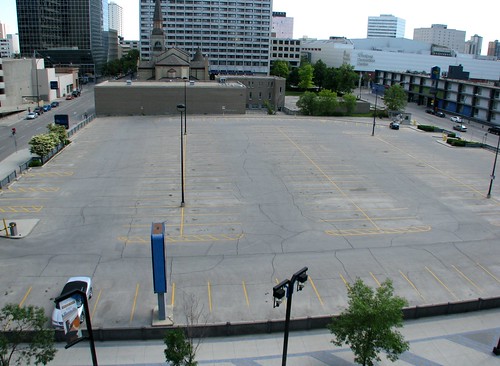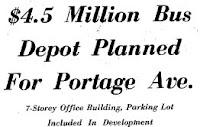© 2009, Christian Cassidy
Image from: Suburban Winnipeg Buses by W. A. Luke
With news that the new Greyhound Bus Depot will soon open at the airport, here's a look back at Winnipeg's two earlier bus depots of note.
The first centralized bus depot, simply called the suburban bus depot, was built in 1928 for the T. Eaton Company on land they owned at Hargrave and Graham. Eaton's knew that it was in their interest to have all out-of-town passengers arrive and depart the city just meters away from the entrance to their store.
In the early 1930s, the city began looking at building a modern, centralized station, but Eaton's cut them off by promising to expand the one on their site. They leased the building to Manitoba Bus Terminals Ltd. who built a new, $55,000, nine-bay depot that would be used by twelve different bus companies.
 The "Union Bus Depot" was formally opened on Saturday, December 12, 1936. It stretched almost the entire length of the block. It featured featured three waiting areas, a gift shop and
enclosed restaurant. A portion of the building had a second storey where bus operators could lease office space.
The "Union Bus Depot" was formally opened on Saturday, December 12, 1936. It stretched almost the entire length of the block. It featured featured three waiting areas, a gift shop and
enclosed restaurant. A portion of the building had a second storey where bus operators could lease office space.By the late 1950s the bus depot was overcrowded with both buses and passengers. It lacked amenities like a modern coffee shop and was in a run-down state. The time had come for something new.
A number of sites were explored. McFayden Park, then located where Holiday Towers are at York and Hargrave, proved controversial as the 0.4 acre park and playground served the people who lived downtown. Another was at Smith and St. Mary, a plan that would have included a seven- storey building. They were both rejected.
Top: October 4, 1962, Winnipeg Free Press
Bottom: April 2, 1963, Winnipeg Free Press
A late entry to the field was a new development proposed for Colony Street at Portage Avenue. The new Mall Centre would include an office tower, retail mall, 300-car parkade, and a refurbishment and expansion of the Mall Hotel.
On April 2, 1963, with Oxford Leaseholds of Edmonton as the developers and Poole Contractors in charge of construction, architects Moody and Moore released the drawings for the new building.
Construction got underway in spring of 1963 and the Mall Centre opened in stages between fall 1963 and summer 1964.
The
Bus Depot was the last phase of the development to go into operation on June 13, 1964,
though it took a few more weeks before its restaurant, (originally the
Dutch Treat Cafeteria, then a Salisbury House), to open.
Hundreds of people turned up for the ribbon cutting. A Free Press reporter marveled at the amenities, spaciousness, and natural light compared to the old bus depot on Hargrave Street:
Hundreds of people turned up for the ribbon cutting. A Free Press reporter marveled at the amenities, spaciousness, and natural light compared to the old bus depot on Hargrave Street:
"As
an example, only 40 buses were in operation in Manitoba in 1931,
apart from those in local transit service. Today there are nearly 200
non-transit buses operating in the province and they're full of people
who find traveling by bus both comfortable and economical.... In total, the new Bus Depot is everything the traveler could want and more"
(Winnipeg Free Press, Oct 14 1964)

As for the old Union Bus Depot, Eaton's wasted no time demolishing the building to create additional surface parking for their store.
Related:
491 Portage Avenue - Winnipeg Places
Suburban Winnipeg Buses - W. A. Luke
Manitoba Transit Heritage Association
Related:
491 Portage Avenue - Winnipeg Places
Suburban Winnipeg Buses - W. A. Luke
Manitoba Transit Heritage Association














.bmp)


3 comments:
The photos of the interior of the Bus Depot show how much architecture has changed over the past 45 years.
Back then, keeping natural light out was something of a fad. (I almost expected to see Count Dracula somewhere in the crowd. Or maybe he was at the airport that day?)
Today, it's just the opposite, with having as much natural light as possible being the fad.
What a great post!
As a student at the U of W, and a user of Greyhound to head over to Brandon once in a while, the convenience of having a centrally located Bus Terminal like in most other cities in the world (London, NY and Mumbai come to mind) was great!
The move to the airport location is pretty sad, although I can see the convenience for folks who fly in from norther communities to link up with other flights and the bus service.
My feelings are mixed on the issue. I can see some future implications in terms of downtown being Winnipeg's hub.
Thanks for the history lesson though!
@ View - Yes, dingy is out in architecture ! Perhaps window technology has had a lot to do with it ? 30 years ago you probably wouldn't have built the hydro tower in a Winnipeg climate.
@ banana thanks ! I agree a downtown location would have been better.
Post a Comment